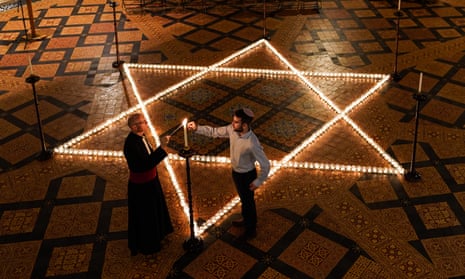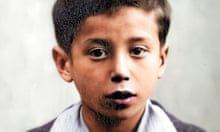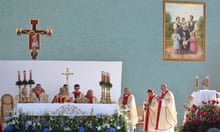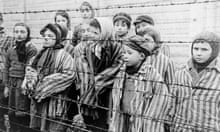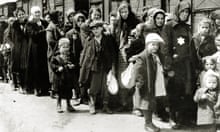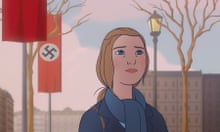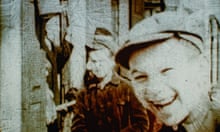Four years after the liberation of the largest Nazi extermination camp, on 27 January 1945, the German philosopher Theodor Adorno observed: “To write poetry after Auschwitz is barbaric.” He came to revise that view, along with its implication that a kind of silence was perhaps the only possible response to the horror of the Holocaust. Later, he wrote that “perennial suffering has as much right to expression as a tortured man to scream”.
Survivor testimony has always been crucial in keeping alive the memory of a unique episode of human depravity. The courage and mental fortitude of those who have borne witness to the industrialised murder of 6 million Jews has played a vital role in helping inoculate European societies against the virus of antisemitism. But that era of witness is coming to an end. During the last five years, almost half the remaining survivors have passed away. On Monday, some 120 Holocaust survivors from around the world will attend a ceremony to commemorate the 75th anniversary of the Red Army’s arrival at the gates of Auschwitz; it is likely to be the last gathering of its kind at a significant anniversary.
Quick GuideWhat happened at Auschwitz?
Show
The Auschwitz concentration camp complex in south-west Poland was the site of the largest mass murder in a single location in human history. While precise numbers are still debated, according to the US Holocaust Memorial Museum, the German SS systematically killed at least 960,000 of the 1.1-1.3 million Jews deported to the camp. More people died at Auschwitz than at any other Nazi concentration camp.
When the camp was liberated on 27 January 1945, Soviet troops found grisly evidence of the horror. About 7,000 starving prisoners were found alive, and millions of items of clothing that once belonged to men, women and children were discovered along with 6,350kg of human hair.
In January 1942, the Nazi party had decided to roll out the “Final Solution”. Camps dedicated solely to the extermination of Jews had been created before, but this was formalised by SS Lieut-Gen Reinhard Heydrich in a speech at the Wannsee conference. The extermination camp Auschwitz II was opened in the same year.
Auschwitz II had the largest prisoner population of any of the three main camps on the site. In January 1942, the first chamber using lethal Zyklon B gas was built. Four further chambers were built, and these were used for systematic genocide up until November 1944.
Auschwitz was also the site of disturbing medical experimentation on Jewish and Roma prisoners, including practices such as castration and sterilisation. SS captain Dr Josef Mengele was one of the physicians practising there.
More than 7,000 Nazi personnel are thought to have served at Auschwitz but only a few hundred have been prosecuted for the crimes committed there. The pursuit of justice has not ceased, with German justice officials saying in 2013 that there were 30 surviving Auschwitz officials who should face prosecution. In 2019, a former guard at Stutthof concentration camp was placed on trial.
But the need to remember and retain the lessons of what became the Holocaust – from its insidious and incremental beginnings in 1930s Germany to the mass factories of death that began their infernal activities in 1941 – grows rather than diminishes. As the experience of the death camps begins to fade from living memory, there are signs that, in a period of resurgent nationalism and xenophobia, postwar taboos are losing some of their force and historical revisionism is being deployed to buttress senses of national self-esteem. In the eastern German state of Thuringia, the nationalist Alternative für Deutschland (AfD) party recently outperformed the centre-right Christian Democrats in elections, under the regional leadership of Björn Höcke. Mr Höcke has in the past railed at the construction of “monuments of shame” such as the Holocaust memorial in Berlin. He has said: “This laughable policy [in Germany] of coming to terms with the past is crippling us.”
In Poland, the Law and Justice party passed a law making it illegal to accuse the Polish nation of complicity in the Holocaust. The government has since watered down the legislation, abandoning the notion of criminal penalties for violators. But one prominent Polish-American Holocaust scholar was questioned under the law, although the case was dropped last year.
In Hungary, the prime minister, Viktor Orbán, has pursued a prolonged dog-whistle campaign against the Jewish philanthropist George Soros, whose arguments in favour of accepting Muslim migrants from the Middle East have been presented as “endangering the Christian culture of Europe”. Meanwhile, in the UK, the Labour party’s failure to effectively combat the use of antisemitic tropes by some members led to a breakdown in its relations with the Jewish community.
A defensive, ethnocentric nationalism which views minorities with suspicion is one of the signs of post-crash times in Europe. Reports of antisemitic incidents are on the rise and political language distinguishing between those who “belong” to the nation and those who do not has become more commonplace. The simultaneous rise of social media has also chipped steadily away at taboos which once set the parameters of acceptable public discourse. There is a pressing need for renewed vigilance, with respect not only to antisemitism but also Islamophobia.
This Holocaust Memorial Day, and the ceremony that will take place in Poland, carry a special poignancy because of the diminishing number of survivors and the landmark nature of the date. Over the last 75 years, survivors have talked in schools and on university campuses; inside museums and at parliaments. These were talks that were often difficult to deliver but which were undertaken out of a sense to duty to both the dead and the living; they helped keep the fire of conscience burning in Europe’s soul. A single human story, told face to face, conveys the tragedy of millions in a way that a recitation of figures never could. But the baton must be passed on and accepted. The Spanish philosopher George Santayana said: “Those who cannot remember the past are condemned to repeat it.” That lesson must never cease to be taught.
